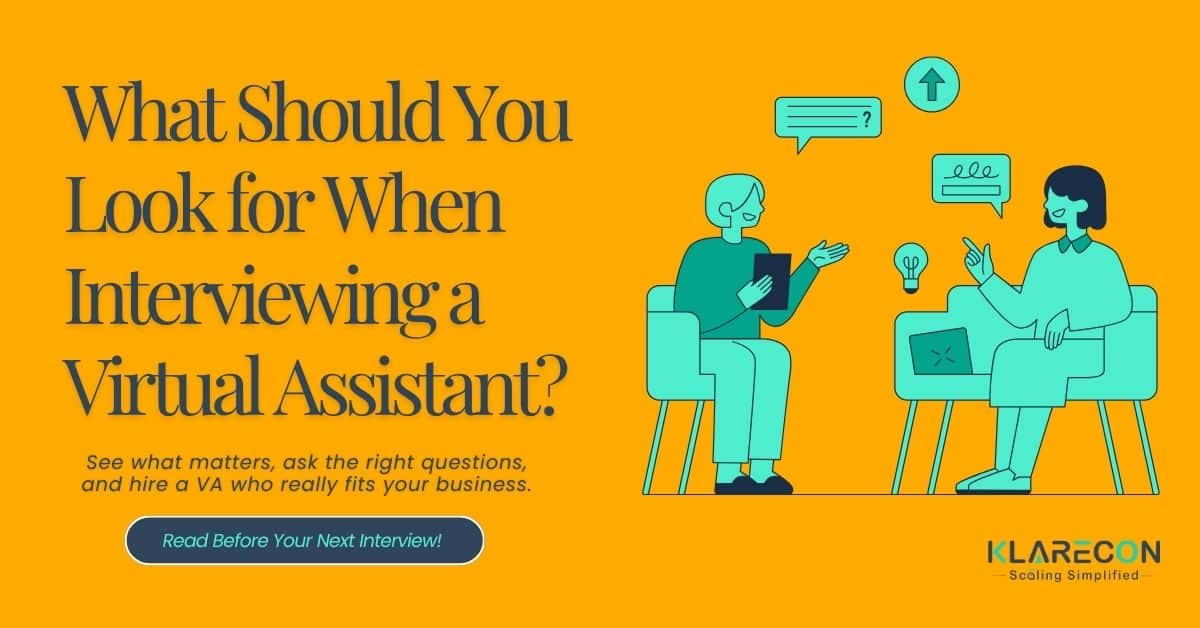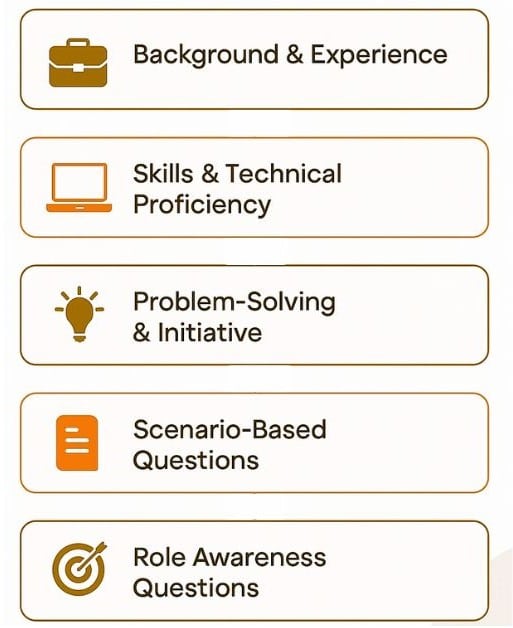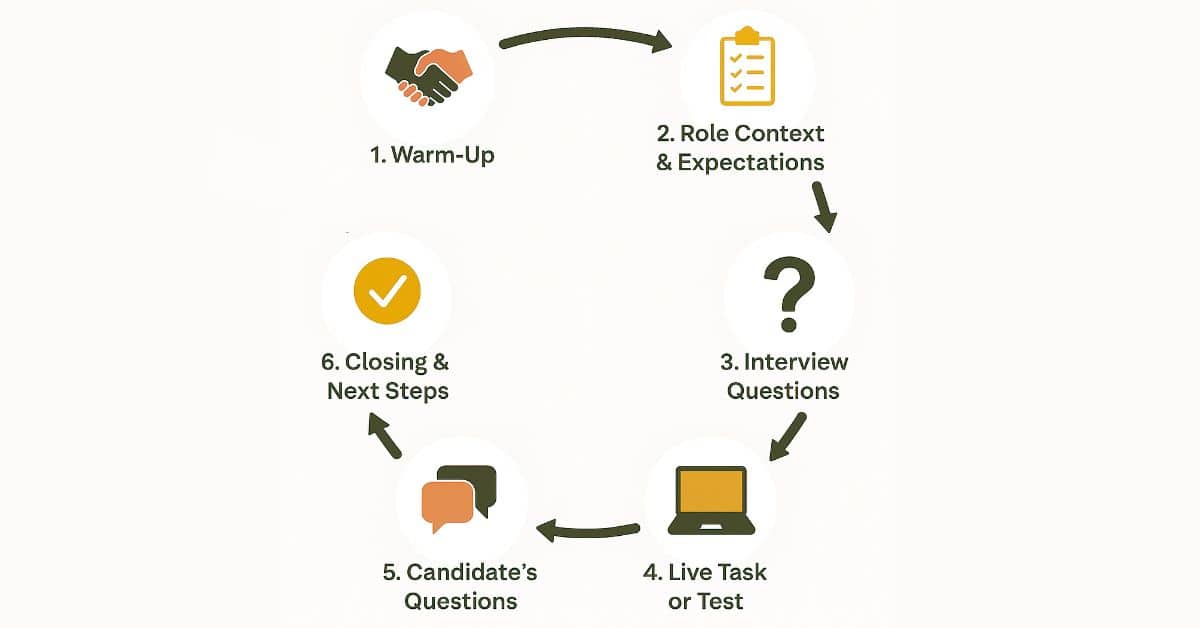
Today, it’s much easier to tap into the skills of people on the other side of the globe. While that’s a big change from what was obtainable decades ago, one thing remains the same: anyone you’re hiring must prove that they are competent enough to do the job.
That’s what interviews are all about. A VA interview is your opportunity to see how skilled, experienced, reliable, and compatible your potential virtual assistant is. When you know what to look out for and the right questions to ask, you’re on your way to finding, from the pool of applicants, a VA that is efficient and will fit into your organization.
In the following sections, we’ll help you find the right candidate by providing guidance on how to interview a VA. You’ll learn what to look out for and find questions that steer you towards discovering the necessary details for making an informed decision.
Types Of Questions To Cover In A VA Interview
Before we get into other aspects of your interview with a VA, let’s first cover the core of any interview—questions. There are several kinds of questions you can ask in an interview, each providing a unique insight into the prospect. Here are a few of them.

Background & Experience
These questions aim to assess how similar their previous roles are to the one they’re aiming for and whether they understand what’s typically expected of the role. They could encompass their work history, task-specific experience, achievements, challenges faced, and other relevant aspects.
A question on background and experience may look like this:
- “Can you walk me through your previous VA roles and the kind of tasks you handled?”
- “Which industries or clients have you worked with, and what did you enjoy most about those experiences?”
Skills & Technical Proficiency
You want to ensure that the prospect can adapt to your tech stack or, at the very least, possess the skills that make it easy to do so. This is why some of the best questions to ask a virtual assistant are about their knowledge of tools and task-specific skills.
- “What tools or platforms are you most comfortable with?”
- “How do you usually manage calendars, schedule meetings, or handle travel arrangements?”
- “What steps do you take when figuring out a tool you’ve never used before?”
With questions like these, you can understand their approach to adopting tools and predict whether they can utilize your existing options or catch up quickly.
Problem-Solving & Initiative
Asking questions like “If you don’t know how to do something, what steps do you usually take?” or “Tell me about a time you solved a problem for a client without being asked” gives insights into how independent or resourceful they are.
To make your work flow smoother, you need a VA who won’t act as a robot but who can show initiative when faced with a problem. The answers you get won’t only tell you if they are proactive in solving problems but also if they have the right approach to doing so.
Scenario-Based Questions
Interview questions for virtual assistants should also include hypotheticals. While these situations may not be guaranteed to happen, they reveal practical skills and test how quickly individuals can think on their feet to solve problems. Ask these questions and you’ll also learn more about the prospect’s communication style and see how much they have learned from their months or years of experience in their previous roles.
These questions can be simple or detailed, and here are examples of both.
Simple:
“If you’re given two tasks at the same time — scheduling a meeting and drafting a quick email — how would you decide which to do first?”
Complex:
“What if you’re managing my inbox and come across three urgent emails: one from a client requesting a meeting within the next 24 hours, another from a vendor needing immediate clarification on an invoice, and a third from a team member asking for help finalizing a shared document before a deadline later today. How would you: (1) prioritize these tasks, (2) communicate your plan to me, (3) manage your time to complete them, and (4) ensure accuracy and follow-up after each task?”
With the complex option, you can gauge many things from their answer, including how well they prioritize, communicate, manage time, and take initiative.
Resume-Based Questions
Reading resume info helps, but what helps even more is when the prospect explains it even further. When you come up with questions regarding the parts of the resume that you don’t fully understand or need more details on, you are able to better understand if they fit into your organization or not.
Note that it’s a common job-seeking tactic for prospects to exaggerate information on their resume to impress employers or even make false claims about their experiences and impact. That’s where resume-based questions come in handy. With them, you verify the authenticity of the information and claims contained in the resume.
These questions look like this:
- “You noted that you improved workflow efficiency in your last role. How exactly did you do that, and what was the outcome?”
- “There’s a gap between your last two roles — can you tell me what you were focused on during that time?”
- “You’ve listed that you managed a team of 4 VAs. Can you elaborate on your managerial responsibilities? What worked for you and what didn’t?”
Role Awareness Questions
These questions help you understand if the prospect understands the job role they are applying for, or if they are really interested in it and not just applying because they need some quick cash. Also, it indicates whether they conducted research on your business to determine how they align with it before expressing interest in the role.
- “What part of VA work do you find most enjoyable or rewarding?”
- “Why does this role interest you compared to other opportunities you might have?”
- “What do you understand about this VA role so far?”
- “What can we do to help you succeed in this role?”
Questions like this will quickly reveal a serious VA.
How To Structure The Interview
Every interview must have a structure. Imagine how weird it would be if you were the applicant and your potential employer just popped in and started bombarding you with questions about your favorite work tools. You want to follow a structure, so every aspect has a natural transition.
There is no set-in-stone structure that every VA interview must follow, but here is something you can use for a smooth process or tweak to fit your objectives.

Step 1: Warm-Up
Greet your applicant warmly and make them feel welcome. After that, you can proceed to have a light conversation with them. You can ask them about where they’re from or how their day has been so far. A few follow-up questions to show genuine interest is a great idea too, but avoid overdoing it because that is not the core of the meeting.
Then you can break down the flow of the interview, so they know what to expect as the conversation progresses. This will go a long way to calm their nerves, build rapport, and ease them into the next steps. Ideally, this shouldn’t take more than four to five minutes.
Step 2: Role Context & Expectations
Now, you’re taking over the stage to talk to them about the role. This is where you explain the reason for hiring, which can be anything from expansion to specific goals. You’ll also share the key responsibilities and expectations here.
Doing this early will help the VA know how to tackle your questions. With this context, they can narrow down their answers to align with your interpretation of the role and expectations, rather than just providing generic responses.
This is also where you clarify whether your work with them is contractual or long-term, and mention opportunities for growth. If quality work can lead to more hours, a salary increase, a promotion, or access to additional business resources, inform them at this stage.
Step 3: Interview Questions
It’s now time to proceed with the questions. Note that even the questions must follow a sequence. You can’t jump from a role-awareness question to an experience question, then over to a resume-based question, and back to a role-awareness question.
Organize your questions into sections beforehand, and tackle them one by one. Again, there are no rules for it. For some interviewers, starting with role-awareness questions is best, while others prefer to begin with background and experience questions. Some end with problem-solving and scenario-based questions, and when you think about it, you may just agree with me that that’s a great way to end the question section.
Here’s a flow we recommend:
- Role Awareness Questions → to confirm motivation, interest, and understanding of the role.
- Resume-Based Questions → to validate experience and clarify details from their background.
- Skills & Technical Proficiency → to check adaptability to tools and ability to handle tasks.
- Problem-Solving & Initiative → to measure independence, resourcefulness, and proactive thinking.
- Scenario-Based Questions → to test real-time judgment and communication style.
Step 4: Live Task / Practical Test (Optional)
Many interviewers don’t bother with this during a virtual interview, but if you feel like going through with it, it’s a great way to test how candidates apply their skills in real-time and whether their performance matches the confidence shown in their answers.
You may not have the time to conduct an interview that lasts up to an hour, so you want to keep this task or test simple, and by that I mean something that’s doable in 5-7 minutes—less is even better.
- Ask them to quickly draft a professional reply to a sample client inquiry.
- Give them three tasks with different urgency levels and have them rank them with reasons.
- Provide a short, messy list and ask them to quickly reformat it neatly in a table.
- Share a short text with small errors and ask them to spot and correct them.
- Give them a vague instruction (e.g., “organize files”) and ask how they’d clarify or break it into steps.
These are some simple tasks that can demonstrate their competence and won’t take much of your time. All you need to do is observe their speed, accuracy, and clarity of communication.
Step 5: Candidate’s Questions
Now, it’s the VA’s chance to ask questions. Give them a few minutes to ask questions about your business and your expectations. Many would ask questions about what you define as success in that role, while some may even ask you tricky questions, like the reason you fired someone in that role in the past.
Some questions you may hear are:
- “What does a typical day look like in this role?”
- “How do you usually work with your VAs — more hands-on or more independent?”
- “How do you prefer updates — daily check-ins, weekly reports, or only when needed?”
Their questions will show how interested they are or how much they have learned working in that role in the past. You can look up questions that candidates frequently ask, and use them to prepare for this section.
Step 6: Closing & Next Steps
It’s time to wrap up, so thank them for their time and then proceed to share the decision-making timeline. Also, share how you’ll follow up with them, so they can easily look out for your final decision. You may even ask them how they prefer to be contacted, to see if it’s something you might want to consider. And that’s how you have a successful interview session.
Potential Red Flags
An interview is not just a time to collect information that determines whether a VA is a good fit for your business, but also a time to spot signs that they aren’t. Since interviews happen in real time, often over video calls, you have a rare chance to read between the lines and monitor body language before reaching a final decision.
I spoke to a few managers at Klarecon involved in our hiring process, asking about what they consider red flags during interviews. I collected their responses and grouped them into a few points. Let’s get to them.
Inconsistent Or Unclear Responses
This can happen in the form of generic answers, mismatched resume-interview answers, unspecific answers, and rambling.
If a VA is asked which project management tools they have used, a response like, “I have used several tools and I can even adapt to whatever you’re using right now,” doesn’t work. Instead, they should give examples, like Monday or Trello. They must be specific, or else, it’s safe to assume the reason they’re not is because they haven’t used any of these tools.
Also, interviewers notice when answers don’t match what’s in a VA’s resume. This is why VAs should always keep their resumes honest and accurate. It’s beautiful to see on a resume that someone “managed social media accounts for multiple clients and increased engagement by 40%.” But it’s not a good look when an interviewer asks what platforms were managed and how growth was tracked, and the response is, “Oh, just different platforms, and I was mostly just posting things and checking likes.”
Rambling is even funnier. Just imagine someone being asked which project management tools they’ve worked on, and they go on to give a 100-word response without actually mentioning any specific tool. A lot of words with no real answers only signal a lack of clarity, and that leaves a poor impression.
Communication Concerns
Besides how candidates respond to our questions, interviewers also check other aspects of communication, such as poor, unprofessional, and careless communication.
A prospect may have intended to make a lot of sense when answering a question and probably knows what they’re saying. But if the answer is delivered in a way that the interviewer can’t make sense of, it’s a crimson flag.
Also, interrupting or speaking over the interviewer shows a lack of respect for them, and the same can be said for using swear words. In our books, VAs don’t get points for “fine” or “okay” answers when details are needed or when they appear distracted during the interview. Their attention should be on the interviewer, not on their phones or a different background task.
Lack Of Integrity Or Accountability
It is expected that candidates not only maintain integrity but also be accountable.
First, there’s no need for one to pretend to know what they don’t. Clients are not looking for perfection—just competence—and every new role is an opportunity to keep learning. We’ve had a candidate who typed the interviewer’s question into an AI tool in real-time and read the answer back to them. These things are obvious and show an unreliable VA.
Also, a candidate blaming their past employer for not exposing them to new tools and opportunities for growth is a red flag. Growth is primarily the candidate’s responsibility, so they should take the initiative by learning on their own and seeking out new challenges within their field. While it’s true that learning often accelerates when the job demands it, with the abundance of free resources available online today, there’s no reason to wait for that push to start learning.
Vague & Generic Answers
An interview should give the interviewer insights into a person’s experiences, not a recitation of what they Googled a few days ago. Generic answers posted on interview preparation sites are intended to provide assistance with structuring answers, but some candidates copy these answers to pass them off as their own, and many interviewers get turned off once they notice.
Also, during an interview, some questions require the candidate to pause and think before responding, especially scenario-based or deeper-level questions. When such questions come up, vague answers like, “I’d just try to do them all as best I can and maybe ask for clarification,” don’t do candidates any favors.
Interviewers are left second-guessing a candidate’s skills and ability to solve problems if they keep giving replies that show that they can’t think deeply.
Technical & Setup Problems
Constant glitches during communication show a VA that hasn’t set up a reliable work system. Before an interview, a candidate must confirm the strength of their internet and the reliability of power, and plan around them. We understand that mistakes happen, but that doesn’t change the fact that it’s a turn-off if the whole call keeps buffering or the interview ends halfway because the candidate’s laptop died.
Here’s something to think about: if a VA can’t prepare adequately for a 15-30-minute interview call, will they be able to handle internet-based tasks and maintain steady communication when they start working for 8 hours a day?
Conclusion
You may ask, “If many businesses and clients follow rigorous processes for each VA interview, how come they still let VAs go after a while?” Good question! The truth is that a good interview process doesn’t guarantee a flawless hire. This is something every business will learn as they keep recruiting.
However, knowing the signs to look out for and asking the right questions will help you spot red flags when hiring VAs and increase your chances of finding one you won’t regret working with. At the very least, it helps you weed out the poor fits. And when you find the right fit, here are some helpful tips for onboarding them.
